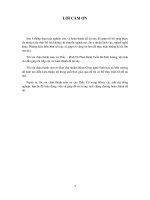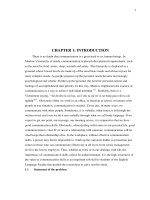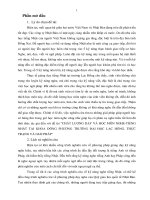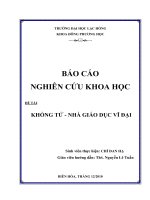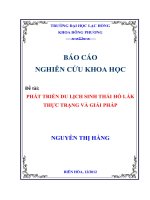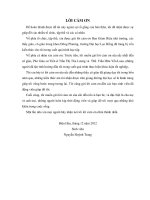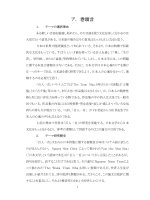Báo cáo nghiên cứu khoa học " Fisheries Research Priorities 2007-2012 " ppt
Bạn đang xem bản rút gọn của tài liệu. Xem và tải ngay bản đầy đủ của tài liệu tại đây (128.81 KB, 15 trang )
Collaboration for Agriculture and Rural Development (CARD) Program
Ministry of Agriculture &
Rural Development
Fisheries Research Priorities 2007-2012
Priority Setting Workshop
Nga Trang
March 2007
Fisheries Research and Development Priorities i
TABLE OF CONTENTS
1 Introduction 1
2 Methodology 2
2.1 Objectives 2
2.2 Research Priority Framework 2
2.3 Pre-Workshop Preparation 3
2.3.1 Organisation and Planning 3
2.3.2 Training in Priority Setting Methodology 3
2.3.3 Areas of Research Opportunity 3
2.3.4 Data & Evaluation Sheets and Workshop Instructions 4
2.4 Workshop Format 4
2.4.1 Workshop Venues and Format 4
2.4.2 Workshop Chairpersons and Group Facilitators 4
2.4.3 Workshop Process 5
3 Workshop Results 5
3.1 Return on Investment 5
3.1.1 Comment 6
3.2 Attractiveness 7
3.2.1 Comment 8
3.3 Feasibility 9
3.3.1 Comment 10
4 Priorities within ARDOs 11
5 Investment Portfolio 12
6 The Next Steps 13
Attachments
1. Fisheries Sub-sector Priority Setting Workbook
2. Fisheries Sub-sector Priority Setting Data and Information Sheets
Fisheries Research and Development Priorities 1
1 Introduction
The Government of Vietnam’s Socio-Economic Plan outlines the government’s
expectations for agriculture and rural development. The Ministry of Fisheries (MoFi now
part of the Ministry of Agriculture and Rural Development, MARD) provides research
services for the aquaculture, marine fisheries, and the fish processing industries.
Fisheries production has increased more than three fold since the mid-1980s and export
revenue has risen to more than US$2.5 billion. The fisheries sector has therefore become
a major component of the national economy and is one of the main earners of foreign
exchange for Vietnam.
Research, particularly aquaculture research, has made a significant contribution to the
fisheries sub-sectors’ growth. Much of that has been driven by rapid expansion of tiger
shrimp production systems, with this industry providing more than US$1 billion of export
revenue. The rapid growth of the fisheries sector, while it has provided producers with
much improved income, is now facing some considerable challenges including issues
relating to disease, quality, food safety and the environment. The industry also faces
increased competition and falling prices for some of the larger export fisheries products.
Vietnam’s accession to the WTO is likely to increase competition and at the same time
require export products to meet much more stringent sanitary and phyto-sanitory
restrictions.
The challenges for research have also changed. The emphasis on production through
increasing areas and numbers of producers is coming to an end. The emphasis is likely to
shift to greater diversification in production, a focus on higher value species, value
adding and development of better management systems incorporating sustainable and
environmental friendly production systems, and cost effective management systems. The
opportunities for research to contribute to continued expansion in the contribution of the
fisheries sector to the national GDP have increased and the research issues have become
more complex. However there is limit to the research resources (human, financial and
infrastructure) that can be directed towards delivery of benefits from research. Because
of the limit on resources it is necessary for the fisheries research community to be
selective in investing those resources in priority research programs that are most likely to
provide the highest return on investment.
A key policy question is what research to invest in. The development of a research
priority framework and research investment portfolio is the first step of a research
strategy that will lead to improved relevance and impact of research. Research priority
setting is therefore an important step in the research resource allocation process.
Methodologies for priority setting have been adapted for use in Vietnam in conjunction
with the AusAID funded Collaboration for Agriculture and Rural Development (CARD)
Program.
This report details the methodology and results obtained from the Fisheries Research
Priority Workshops held in Nga Trang on December 17
th
2006. The research priorities
determined at this workshop is the first step in identification of priority research
Fisheries Research and Development Priorities 2
programs and the determination of a research investment portfolio. Once this task is
complete MARD will prepare and publish its Medium-Term Fisheries Research Plan.
2 Methodology
2.1 Objectives
To demonstrate an appropriate priority setting methodology suitable for future use
by MARD (MoFi).
To determine the priorities for investment in Areas of Research and Development
Opportunity (ARDOs) for the Fisheries Sub-sector
To determine the relative priority of fish crops/products within ARDOs
To outline the next steps in development of research strategies for high priority
research programs and the development of a Medium-Term Research Plan.
2.2 Research Priority Framework
Priority analysis is based on a criterion based analytical framework
1
, which has been
adapted to conditions in different developing countries.
The conceptual framework is shown in Figure 1.
Figure 1 Research Priority Framework
The Methodology was detailed in a Workshop Workbook (Attachment 1) supported by
ARDO Data and Information Sheets (Attachment 2).
1
Foster, R.N., Linden, L.H., Whiteley, R.L., and Kantrow, A.M., Improving the Return on R & D, in
‘Measuring and Improving the Performance and Return on R & D’ IRI, New York (originally published in
Research Management January 1985.
Fisheries Research and Development Priorities 3
The workshop aim was to create ownership through developing a consensus between
users and providers of research for the research priorities. Seventy stakeholders,
representing researchers and research managers, extension workers, universities and the
private sector enterprise and researchers participated in the workshop.
The workshop process required individual participants to score each Area of Research &
Development Opportunity (ARDO) for each of the 4 criteria (Potential Benefits, Ability
(or constraints) to Capture Benefits, Research Potential and Research Capacity) before
they attended the workshop. Working groups, facilitated by trained MoFi and MARD
staff, discussed the reasons behind individual priority scores and each participant was
invited to rescore if they desired. Individual Scoring Sheets were collected and entered in
an EXCEL Spreadsheet.
Within each of the ARDOs the fish crops/species that made up the ARDOs were also
prioritised as a first step towards the development of multi-disciplinary priority research
programmes.
2.3 Pre-Workshop Preparation
2.3.1 Organisation and Planning
MARD established a Research and Development Priority Setting Working Group (WG).
MoFi was represented on this working group to assist in the development of
methodologies and processes that could be applied across all sub-sectors of the Primary
Sector (Agriculture, Forestry, Fisheries and Livestock). The WG’s task was to provide
the authority and direction for establishment of agricultural research priorities. A
workshop outlining the priority setting process was presented to the WG and individual
WG members undertook to promote the process and facilitate and chair priority setting
workshops.
2.3.2 Training in Priority Setting Methodology
MARD established a Monitoring and Evaluation Network (M&EN). MoFi
representatives were active members of the M&EN which consisted of staff from the
Department of Science and Technology (DST) and staff from research institutes with
responsibility for monitoring and evaluation. Two workshops were completed with the
M&EN and at the conclusion of these workshops 12 M&EN members from MARD and
MoFi had demonstrated their understanding of the methodology. M&EN members
facilitated priority setting planning workshops and provided group facilitation services at
national priority setting workshops.
2.3.3 Areas of Research Opportunity
A workshop of key research staff from Fisheries Research Institutions participated in a
preliminary workshop designed to reach agreement on Fisheries ARDOs.
Nine ARDOs were defined. The format for each ARDO of the Data and Evaluation
Sheets was outlined. Key staff from Research Institutions with a broad knowledge of the
fisheries industry and specialist technical expertise were identified and appointed as
Fisheries Research and Development Priorities 4
ARDO Leaders. The ARDO Leaders took responsibility for preparing draft Data and
Evaluation Sheets.
The Nine ARDOS were:
ARDO 1: Marine Finfish
ARDO 2: Cold Water Fish
ARDO 3: Crustaceans
ARDO 4: Mollusks
ARDO 5: Fresh Water Fish
ARDO 6: Post Harvest, Processing & Value Adding
ARDO 7: Extraction of Bio-Active Compounds
ARDO 8: Resource Management & Conservation
ARDO 9: Mechanisation
2.3.4 Data & Evaluation Sheets and Workshop Instructions
Draft Data and Evaluation Sheets were prepared and the PMU critiqued and edited them
to ensure that critical information was supplied and all data and evaluation sheets had a
similar format and content. Data and Evaluation Sheets for each of the 9 ARDOs were
prepared as a separate publication (Attachments 1 and 2) and distributed to invitees prior
to the workshop. The methodology was outlined and each workshop participant was
asked to read all workshop material and make a preliminary score for each of the four
evaluation criteria.
2.4 Workshop Format
2.4.1 Workshop Venues and Format
One workshop was facilitated at the University of Fisheries, Nga Trang on December 17
th
2006.
2.4.2 Workshop Chairpersons and Group Facilitators
Dr Vu Van Trieu (ICD- MoFi) and Pham Van Tho (DST-MoFi) took dual responsibility
for Chairing the Priority Setting Workshop.
Members of the M&EN and additional Fisheries research institute staff met with the
CARD Technical coordinator prior to each workshop to outline the process of facilitation
of work tables during the priority setting workshop. Workgroup Facilitators were:
Ho Manh Tuan (Nha Trang University)
Nguyen Quoc Nghi (DST- Mofi)
Hoang Tung (Nha Trang University)
Nguyen Thi Kim Anh (Nha Trang University)
Doan Thanh Loan (RIA1)
Nguyen Dinh Luan (RIA1)
Mai Van Ha (RIA1)
Fisheries Research and Development Priorities 5
2.4.3 Workshop Process
The workshop followed the following steps:
1. Workshop format and process outlined, including a brief description of the
methodology and an outline of the priority framework
2. Detailed description of the Potential Benefit evaluation criteria including the key
assessment issues
3. Preliminary scoring for Potential Benefits for each ARDO by each workshop
participant
4. Work table discussion on reasons for high and low scores for Potential Benefits
and reassessment of preliminary scores by each participant
5. Collection of individual scoring sheets and entry of individual scores for Potential
Benefit for each ARDO.
6. Repetition of steps 2 – 5 for each of the remaining evaluation criteria (Ability to
Capture, Research Potential and Research Capacity
7. Formation of specialist groups for each ARDO and prioritisation of crops/outputs
within each ARDO
8. Presentation of workshop results to participants
9. Outline of Next Critical Steps in the development of research priorities
3 Workshop Results
3.1 Return on Investment
Return on investment is the product of attractiveness and feasibility. The relative return
on investment in each area of research opportunity is summarised below
Fisheries Research and Development Priorities 6
28
Workshop Output – Return on
Investment
9. Mechanisation
8. Resource Management &
Conservation
7. Extraction of Bio-Active
Compounds
6. Post-Harvest Processing
and Value Adding
5. Fresh water Fish
4. Mollusks
3. Crustaceans
2. Cold Water fish
1. Marine Finfish
RET URN FROM INVESTMENT IN EACH AREA
OF RESEARCH OPPORTUNITY
1
2
3
4
5
6
7
8
9
0
20
40
60
80
0 20 40 60 80
Feasibility
Attractive-
ness
3.1.1 Comment
The main points arising from the workshop’s Return on Investment assessment are:
Highest Return on Investment
The highest return on investment in research is for Crustaceans. This reflects a
large industry resulting in a high potential impact from this ARDO and the
assessment that research has a relatively high contribution towards achieving the
potential impact. The assessment of research capacity in this ARDO suggests that
it is relatively good, but for crustaceans there may be a need to review the mix of
research skills and shift from an emphasis on production to further develop
research skills in productivity, better management practices, disease control and
management and improvement in quality and food safety. These changes might
lead to improved feasibility leading to an even higher return on investment.
Medium Return on Investment
This group of ARDOs includes Freshwater Fish, Marine Finfish, Post-harvest
Processing and Value Adding, and Resource Management and Conservation.
The assessment suggests that slightly higher returns will accrue from investment
in Freshwater Fish and Marine Finfish than for the other two ARDOs in this
group. This is possibly due to a higher ability for uptake of interventions that will
improve potential benefit. There appears to be a research capacity issue for
Fisheries Research and Development Priorities 7
Marine Finfish. Additional skills and funding in this ARDO is likely to improve
return on investment.
The role of the private sector in Post-harvest Processing and Value Adding
appears to be important as it is likely that most of the improvement in feasibility
(and therefore return on investment) will arise through private sector investment
and importation of modern equipment and processes.
Low Return on Investment
While there is a relatively high potential benefit from improved Resource
Management and Conservation, the return on investment is lowered because of
the difficulty in applying good resource management practices in the Vietnam
environment.
Return on investment in Cold Water Fish, Mechanisation and Bioactive
Compounds is limited by a combination of factors including the size of the
ARDO, the potential for domestic or export market development, a difficult
technology adoption environment and limits in the contribution of research to
industry development.
3.2 Attractiveness
Attractiveness is a realistic estimate of the relative benefits likely to be achieved. It is
assessed by plotting ARDO Potential Benefits to Vietnam against the Ability to Capture
those benefits (Likelihood of Uptake). The Figure below summarises the scores provided
by individual participants at the workshop.
Fisheries Research and Development Priorities 8
26
Workshop Output - Attractiveness
9. Mechanisation
8. Resource Management &
Conservation
7. Extraction of Bio-Active
Compounds
6. Post-Harvest Processing
and Value Adding
5. Fresh water Fish
4. Mollusks
3. Crustaceans
2. Cold Water fish
1. Marine Finfish
POTENT IAL IMPACT OF R&D FOR EACH ARDO
1
2
3
4
5
6
7
8
9
0.0
2.5
5.0
7.5
10.0
0.0 2.5 5.0 7.5 10.0
Likelihood of uptake
Potential
Benefits
3.2.1 Comment
The main points arising from the workshop’s Attractiveness assessment are:
High Attractiveness
The ARDOs of Crustaceans, Marine Finfish and Freshwater Fish were seen to
provide the highest potential benefit.
The high score for crustaceans probably reflects the size of the industry that
generates almost 50% of the value of the fisheries sector. A relatively small gain in
value through application of improved technology is likely to provide a relatively
large benefit in terms of total value to the industry. The ability to adopt improved
technology is also rated high and this reflects the experience of producers in the
shrimp industry and existence of suitable infrastructure for production.
In contrast the high score for Marine Finfish probably reflects high value of species
such as grouper, the development of larger scale production systems and the
prospects for rapid expansion of the industry resulting in increased employment
opportunities. Marine Finfish is seen as a potential alternative production system
for shrimp farmers who have problems with disease management. The ability to
adopt is lower than for crustaceans. One reason for this is that Marine Finfish is a
relatively new production system and the cost of establishment may limit the ability
of smallholders to adopt. However the interest in larger scale production systems
Fisheries Research and Development Priorities 9
financed by the private sector may result in a higher adoption rate of new
technology by the private sector.
The size of the freshwater fish industry indicates that significant benefits will
accrue from improvements in production and especially in value adding. As many
aquaculture enterprises rely on the natural resource for seed, sound resource
management and conservation practice is essential. However the difficulty in
implementation of resource management and conservation is recognised by a low
likelihood of uptake for freshwater fish.
Medium Attractiveness
The next group of ARDOs includes Mollusks, Post-harvest Processing and
Resource Management and Conservation.
There is increasing emphasis on Mollusks as the domestic market is likely grow
significantly and there are good opportunities for development of international
markets. In addition there is significant potential for using mollusks as a
companion crop to improve environmental conditions and provide feed for marine
fish, shrimps etc. Given the aquaculture experience in Vietnam the likelihood of
uptake is relatively high
Generally the fisheries processing industry is inefficient, the use of modern
processing technology is relatively low and improvement in the diversity and value
of processed products is likely to provide significant increases in export income.
The potential benefit from improvements in processing that add value was rated
relatively highly. Uptake is constrained by the ability of the processing industry to
finance importation of improved processing equipment and processes.
Resource Management and Conservation has medium attractiveness, but lower than
Mollusks and Post-harvest Processing. Potential benefit was relatively high, but
the difficulty of implementation of improved resource management and
conservation practices was recognised.
Low Attractiveness
The low attractiveness ARDOs includes Bioactive Compounds, Mechanisation and
Cold Water Fish. All these ARDOs were considered to have relatively low
potential benefit and relatively low uptake.
There is a good supply of raw material for bioactive compounds and an opportunity
for import substitution, but this will require substantial investment in extraction
facilities and processes, with quality being an issue for export markets.
The low attractiveness for Cold Water Fish reflects the small areas that meet the
requirements for production. However the domestic price is high.
Mechanisation to improve the efficiency and effectiveness of capture fishing, and
the immediate post-harvest handling will require investment by the large number of
relatively small fishing vessels. Adoption is likely to improve as the size of vessel
catch improves, but this will require significant capital resources.
3.3 Feasibility
Relative feasibility a realistic estimate of the likely contribution research would make to
achieve the potential impact. It is determined by plotting research and development
Fisheries Research and Development Priorities 10
potential against research and development capacity. The Figure below summarises the
workshop results.
27
Workshop Output - Feasibility
9. Mechanisation
8. Resource Management &
Conservation
7. Extraction of Bio-Active
Compounds
6. Post-Harvest Processing
and Value Adding
5. Fresh water Fish
4. Mollusks
3. Crustaceans
2. Cold Water fish
1. Marine Finfish
FEASIBILITY OF R&D FOR EACH ARO
9
8
7
6
54
3
2
1
0.0
2.5
5.0
7.5
10.0
0.0 2.5 5.0 7.5 10.0
R&D Capacity
R&D
Potential
3.3.1 Comment
The main points arising from the workshop’s Feasibility assessment include:
R&D Potential
Research in the Marine Finfish ARDO is considered to have a relatively high
contribution towards achievement of potential impact. The high value of marine
finfish and opportunities for value adding suggests that that further research effort
is likely to provide greater benefits than for other ARDOs.
Research in a group of ARDOs (Fresh Water Fish, Crustaceans, Mollusks,
Resource Management and Conservation, Post-Harvest Processing and Value
Adding and Extraction of Bioactive Compounds) has similar, but a lower,
contribution towards achievement of potential impact than Marine Finfish.
The workshop assessed that the R&D potential for Mechanisation and for Cold
Water Fish was relatively low. One reason for this could be that for
Mechanisation, much of the gain in technology may come from importation of
modern and efficient equipment. For Cold Water Fish it is also likely that the
Fisheries Research and Development Priorities 11
private sector will develop specialised and relatively large scale production
systems, using foreign investment and models developed in other countries.
R&D Capacity
There is a view that research capacity could be strengthened in all ARDOs.
However the resource available to improve capacity in all ARDOs is limited. The
main issue is what are the priorities for research capacity development?
Capacity development should also be aligned with research priorities and for
ARDOs that lie above the diagonal line, feasibility (research outputs) could be
improved by an increase in skills and resources. This is particularly evident for
Marine Finfish and Bioactive Compounds.
For ARDOs below the diagonal line, the workshop output suggested that there is
adequate capacity to enable delivery of expected research potential.
In the preparation of capacity development plans, these results suggest that there
may be a potential to transfer some of the existing capacity in Crustacean and Fresh
water Fish and through retraining if necessary direct some of those resources to the
ARDO Marine Finfish.
Skill/capacity transfer is more difficult for Bioactive Compounds and any increase
in capacity in this area would most likely come from new staff.
4 Priorities within ARDOs
The workshop participants ranked fisheries outputs (species/products etc) within each
ARDO. For MoFi this ranking is the first step in identifying priority programs. More
work to develop research strategies for high priority programs is required before the
Fisheries Medium-Term Research Plans. Table 1 lists priority programs within priority
ARDOs.
Table 1: Priority Programs within Priority ARDOs (First Draft)
Priority ARDOs (In Order of Ranking on Return
on Investment)
Priority Programs (Ranking within ARDOs)
ARDO
Number
3
Crustaceans Tiger shrimp
Lobsters
Mud crabs
Giant river prawns
5
Freshwater Fish Catfish
Tilapia
1
Marine Finfish Grouper
Snapper
Cobia
Barramundi
Milk fish
Rabbit fish
Sea Bream
Fisheries Research and Development Priorities 12
4
Mollusks Oyster
Cockle
Clam
Abalone
Sweet snail
Scallop
6
Post-harvest Processing & Value Adding Immediate Post-harvest storage and reduce losses
Safe and effective preservation technology
Processed product diversification, value adding
Use of waste material from processing industries
8
Resource Management & Conservation Fisheries resource survey and analysis
Protection and Recovery of marine ecosystems
Fisheries resource management policy
Efficient fishing gear with low bi-catch
Sea biology biodiversity
7
Extraction of Bioactive Compounds Chitosan extraction and use of active compounds
Sea weed extraction and uses
Extraction of active compounds from fisheries waste
Extraction and use of toxin for medicinal use
2
Cold Water Fish Trout
Sturgeon (Ukraine & China)
White Fish
Indigenous cold water fish
9
Mechanisation Fishing tools and capture technology
5 Investment Portfolio
One of the objectives of priority setting is to enable assessment and adjustment (if
necessary) of the available resource for fisheries research. The aim is to improve the
efficiency of research resource allocation. The revision of research resource use based on
program priorities should be undertaken at regular intervals (every 3-5 years). Priorities
for capacity development and the provision of specialist facilities and equipment should
also be linked to priority programs.
One way of developing and investment portfolio is to make broad allocations of funding
(for all research resources) based on priority ARDOs. These allocation decisions are the
responsibility of research policy decision makers within MARD (MoFi), but as an
example the latest ARDO priority rank could be used to develop indicative future budget
allocations. These could be compared with current budget allocation, and may be used to
indicate shifts in budget allocations over time (3-5 years).
Assuming that it is sensible to set aside 5% of the available budget as being non-allocated
(to be used for specific research perhaps as directed by the Minister, or for support of
new and innovative ideas that are not included in priority programs) an example of an
indicative Fisheries ARDO research portfolio for the 2007 – 2012 timeframe could be as
shown in Table 2.
Fisheries Research and Development Priorities 13
Table 2: Current and Future Fisheries ARDO Research Portfolio and Indicative
Shifts in Budget Allocation.
ARDO (Priority Rank) Future
Indicative
Budget (%)
2
Crustaceans 23
Freshwater Fish 21
Marine Finfish 18
Mollusks 12
Post-harvest Processing & Value Adding 9
Resource Management & Conservation 8
Extraction of Bioactive Compounds 2
Cold Water Fish 1
Mechanisation 1
Non-Allocated 5
Total 100
6 The Next Steps
The identification of Priority Programs within Priority ARDOs should result in more
programs within high priority ARDOs receiving budget support compared with for high
priority programs within low priority ARDOs.
The next steps are:
1. Establish small specialist working groups within each of the agreed priority
programs
2. Define the Program Objective (the Outcome desired) for each priority program.
3. Ensure that the Program Objective leads to establishment of a multi-disciplinary
approach to achievement of the desired Outcome through identification and
prioritisation research strategies (disciplines, research themes).
4. Implement an open and contestable research contracting process that encourages
innovation, collaboration within and between research service providers.
2
Indicative budget percentages based on the workshop assessment of Return on Investment. The final
budget target is to be decided by MARD research policy makers.
